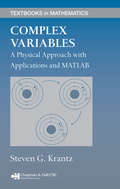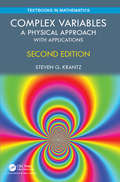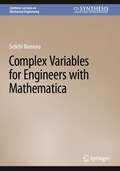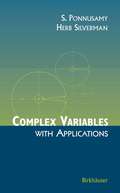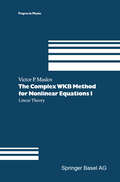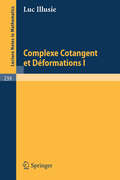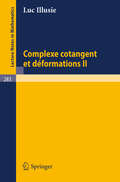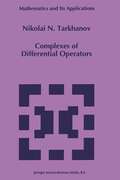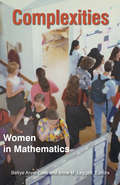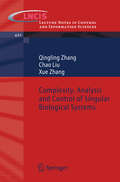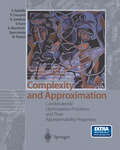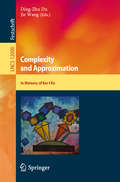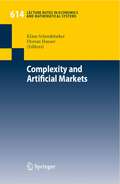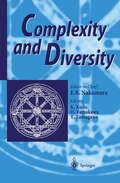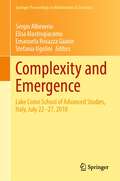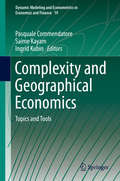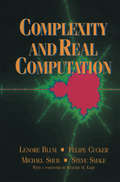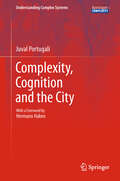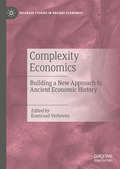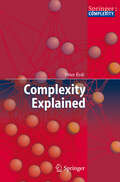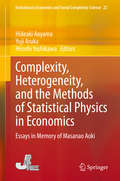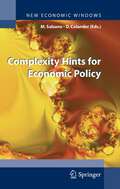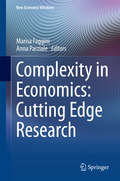- Table View
- List View
Complex Variables: A Physical Approach with Applications and MATLAB (Textbooks In Mathematics Ser.)
by Steven G. KrantzFrom the algebraic properties of a complete number field, to the analytic properties imposed by the Cauchy integral formula, to the geometric qualities originating from conformality, Complex Variables: A Physical Approach with Applications and MATLAB explores all facets of this subject, with particular emphasis on using theory in practice.T
Complex Variables: A Physical Approach with Applications (Textbooks in Mathematics)
by Steven G. KrantzWeb Copy The idea of complex numbers dates back at least 300 years—to Gauss and Euler, among others. Today complex analysis is a central part of modern analytical thinking. It is used in engineering, physics, mathematics, astrophysics, and many other fields. It provides powerful tools for doing mathematical analysis, and often yields pleasing and unanticipated answers. This book makes the subject of complex analysis accessible to a broad audience. The complex numbers are a somewhat mysterious number system that seems to come out of the blue. It is important for students to see that this is really a very concrete set of objects that has very concrete and meaningful applications. Features: This new edition is a substantial rewrite, focusing on the accessibility, applied, and visual aspect of complex analysis This book has an exceptionally large number of examples and a large number of figures. The topic is presented as a natural outgrowth of the calculus. It is not a new language, or a new way of thinking. Incisive applications appear throughout the book. Partial differential equations are used as a unifying theme.
Complex Variables: A Physical Approach with Applications (Textbooks in Mathematics)
by Steven G. KrantzWeb Copy The idea of complex numbers dates back at least 300 years—to Gauss and Euler, among others. Today complex analysis is a central part of modern analytical thinking. It is used in engineering, physics, mathematics, astrophysics, and many other fields. It provides powerful tools for doing mathematical analysis, and often yields pleasing and unanticipated answers. This book makes the subject of complex analysis accessible to a broad audience. The complex numbers are a somewhat mysterious number system that seems to come out of the blue. It is important for students to see that this is really a very concrete set of objects that has very concrete and meaningful applications. Features: This new edition is a substantial rewrite, focusing on the accessibility, applied, and visual aspect of complex analysis This book has an exceptionally large number of examples and a large number of figures. The topic is presented as a natural outgrowth of the calculus. It is not a new language, or a new way of thinking. Incisive applications appear throughout the book. Partial differential equations are used as a unifying theme.
Complex Variables for Engineers with Mathematica (Synthesis Lectures on Mechanical Engineering)
by Seiichi NomuraComplex variable theory is attractive for engineers as it offers elegant approaches for certain types of differential equations in engineering including heat transfer, solid mechanics, and fluid mechanics. However, a gap exists between books written by mathematicians and books written by engineers in their specific fields. Naturally, mathematicians tend to emphasize rigorousness and consistency while less emphasizing applications. On the other hand, books written by engineers often jump directly to the specific topics assuming that the readers already have sufficient background of complex variables and the pathway from theory to the application is not clearly elucidated. This book closes the gap in the literature. providing a smooth transition from basic theory to the application is accomplished. Although it is not possible to cover all the topics in engineering exhaustively, the readers can at least find the logic of how and why complex variables are effective for some of the engineering problems. Another motivation for writing this book is to demonstrate that the readers can take advantage of a computer algebra system, Mathematica, to facilitate tedious algebra and visualize complex functions so that they can focus on principles instead of spending endless hours on algebra by hand. Unlike numerical tools such as MATLAB and FORTRAN, Mathematica can expand, differentiate, and integrate complex-valued functions symbolically. Mathematica can be used as a stand-alone symbolic calculator or a programming tool using the Wolfram Language. If Mathematica is not available locally, Wolfram Cloud Basic can be used online as a free service to execute Mathematica statements.
Complex Variables with Applications
by Saminathan Ponnusamy Herb SilvermanExplores the interrelations between real and complex numbers by adopting both generalization and specialization methods to move between them, while simultaneously examining their analytic and geometric characteristics Engaging exposition with discussions, remarks, questions, and exercises to motivate understanding and critical thinking skills Encludes numerous examples and applications relevant to science and engineering students
The Complex WKB Method for Nonlinear Equations I: Linear Theory (Progress in Mathematical Physics #16)
by Victor P. MaslovComplexes of Differential Operators (Mathematics and Its Applications #340)
by Nikolai TarkhanovThis book gives a systematic account of the facts concerning complexes of differential operators on differentiable manifolds. The central place is occupied by the study of general complexes of differential operators between sections of vector bundles. Although the global situation often contains nothing new as compared with the local one (that is, complexes of partial differential operators on an open subset of ]Rn), the invariant language allows one to simplify the notation and to distinguish better the algebraic nature of some questions. In the last 2 decades within the general theory of complexes of differential operators, the following directions were delineated: 1) the formal theory; 2) the existence theory; 3) the problem of global solvability; 4) overdetermined boundary problems; 5) the generalized Lefschetz theory of fixed points, and 6) the qualitative theory of solutions of overdetermined systems. All of these problems are reflected in this book to some degree. It is superfluous to say that different directions sometimes whimsically intersect. Considerable attention is given to connections and parallels with the theory of functions of several complex variables. One of the reproaches avowed beforehand by the author consists of the shortage of examples. The framework of the book has not permitted their number to be increased significantly. Certain parts of the book consist of results obtained by the author in 1977-1986. They have been presented in seminars in Krasnoyarsk, Moscow, Ekaterinburg, and N ovosi birsk.
Complexities: Women in Mathematics
by Bettye Anne Case Anne M. LeggettSophie Germain taught herself mathematics by candlelight, huddled in her bedclothes. Ada Byron Lovelace anticipated aspects of general-purpose digital computing by more than a century. Cora Ratto de Sadosky advanced messages of tolerance and equality while sharing her mathematical talents with generations of students. This captivating book gives voice to women mathematicians from the late eighteenth century through to the present day. It documents the complex nature of the conditions women around the world have faced--and continue to face--while pursuing their careers in mathematics. The stories of the three women above and those of many more appear here, each one enlightening and inspiring. The earlier parts of the book provide historical context and perspective, beginning with excursions into the lives of fifteen women born before 1920. Included are histories of collective efforts to improve women's opportunities in research mathematics. In addition, a photo essay puts a human face on the subject as it illustrates women's contributions in professional associations. More than eighty women from academe, government, and the private sector provide a rich mélange of insights and strategies for creating workable career paths while maintaining rewarding personal lives. The book discusses related social and cultural issues, and includes a summary of recent comparative data relating to women and men in mathematics and women from other sciences. First-person accounts provide explicit how-tos; many narratives demonstrate great determination and perseverance. Talented women vividly portray their pleasure in discovering new mathematics. The senior among them speak out candidly, interweaving their mathematics with autobiographical detail. At the beginning of a new century, women at all stages of their careers share their outlooks and experiences. Clear, engaging, and meticulously researched, Complexities will inspire young women who are contemplating careers in mathematics and will speak to women in many fields of endeavor and walks of life.
Complexities: Women in Mathematics (PDF)
by Bettye Anne Case Anne M. LeggettSophie Germain taught herself mathematics by candlelight, huddled in her bedclothes. Ada Byron Lovelace anticipated aspects of general-purpose digital computing by more than a century. Cora Ratto de Sadosky advanced messages of tolerance and equality while sharing her mathematical talents with generations of students. This captivating book gives voice to women mathematicians from the late eighteenth century through to the present day. It documents the complex nature of the conditions women around the world have faced--and continue to face--while pursuing their careers in mathematics. The stories of the three women above and those of many more appear here, each one enlightening and inspiring. The earlier parts of the book provide historical context and perspective, beginning with excursions into the lives of fifteen women born before 1920. Included are histories of collective efforts to improve women's opportunities in research mathematics. In addition, a photo essay puts a human face on the subject as it illustrates women's contributions in professional associations. More than eighty women from academe, government, and the private sector provide a rich mélange of insights and strategies for creating workable career paths while maintaining rewarding personal lives. The book discusses related social and cultural issues, and includes a summary of recent comparative data relating to women and men in mathematics and women from other sciences. First-person accounts provide explicit how-tos; many narratives demonstrate great determination and perseverance. Talented women vividly portray their pleasure in discovering new mathematics. The senior among them speak out candidly, interweaving their mathematics with autobiographical detail. At the beginning of a new century, women at all stages of their careers share their outlooks and experiences. Clear, engaging, and meticulously researched, Complexities will inspire young women who are contemplating careers in mathematics and will speak to women in many fields of endeavor and walks of life.
Complexity, Analysis and Control of Singular Biological Systems (Lecture Notes in Control and Information Sciences #421)
by Qingling Zhang Chao Liu Xue ZhangComplexity, Analysis and Control of Singular Biological Systems follows the control of real-world biological systems at both ecological and phyisological levels concentrating on the application of now-extensively-investigated singular system theory. Much effort has recently been dedicated to the modelling and analysis of developing bioeconomic systems and the text establishes singular examples of these, showing how proper control can help to maintain sustainable economic development of biological resources. The book begins from the essentials of singular systems theory and bifurcations before tackling the use of various forms of control in singular biological systems using examples including predator-prey relationships and viral vaccination and quarantine control. Researchers and graduate students studying the control of complex biological systems are shown how a variety of methods can be brought to bear and practitioners working with the economics of biological systems and their control will also find the monograph illuminating.
Complexity and Approximation: Combinatorial Optimization Problems and Their Approximability Properties
by Giorgio Ausiello Pierluigi Crescenzi Giorgio Gambosi Viggo Kann Alberto Marchetti-Spaccamela Marco ProtasiThis book documents the state of the art in combinatorial optimization, presenting approximate solutions of virtually all relevant classes of NP-hard optimization problems. The wealth of problems, algorithms, results, and techniques make it an indispensible source of reference for professionals. The text smoothly integrates numerous illustrations, examples, and exercises.
Complexity and Approximation: In Memory of Ker-I Ko (Lecture Notes in Computer Science #12000)
by Ding-Zhu Du Jie WangThis Festschrift is in honor of Ker-I Ko, Professor in the Stony Brook University, USA. Ker-I Ko was one of the founding fathers of computational complexity over real numbers and analysis. He and Harvey Friedman devised a theoretical model for real number computations by extending the computation of Turing machines. He contributed significantly to advancing the theory of structural complexity, especially on polynomial-time isomorphism, instance complexity, and relativization of polynomial-time hierarchy. Ker-I also made many contributions to approximation algorithm theory of combinatorial optimization problems. This volume contains 17 contributions in the area of complexity and approximation. Those articles are authored by researchers over the world, including North America, Europe and Asia. Most of them are co-authors, colleagues, friends, and students of Ker-I Ko.
Complexity and Artificial Markets (Lecture Notes in Economics and Mathematical Systems #614)
by Klaus Schredelseker Florian HauserIn recent years, agent-based simulation has become a widely accepted tool when dealing with complexity in economics and other social sciences. The contributions presented in this book apply agent-based methods to derive results from complex models related to market mechanisms, evolution, decision making, and information economics. In addition, the applicability of agent-based methods to complex problems in economics is discussed from a methodological perspective. The papers presented in this collection combine approaches from economics, finance, computer science, natural sciences, philosophy, and cognitive sciences.
Complexity and Diversity
by E. R. NakamuraNonlinear complex open systems show great diversity in the process of self-organization, and that diversity increases as complexity increases. The measurement of complexity and the origins of the diversity of such complex systems are the focus of interdisciplinary studies extending across a wide range of scientific disciplines that include applied mathematics, physics, chemistry, biology, psychology, ecology, sociology, and economics. Previous investigations have concentrated either on complexity or on diversity, but not both. This volume makes clear the relation between complexity and diversity with examples drawn from various disciplines. Compiles here are presentations from the Complexity and Diversity workshop held in Fugue, Japan, in August 1996. The contributions are the results of research in mathematical systems, physical systems, living systems, and social systems, and are contained in the four corresponding sections of the book. Mathematical expressions for the theory of complexity as a fundamental method along with realistic examples for application of systematic methods provide the reader with ready access to the latest topics in complex systems.
Complexity and Emergence: Lake Como School of Advanced Studies, Italy, July 22–27, 2018 (Springer Proceedings in Mathematics & Statistics #383)
by Sergio Albeverio Emanuela Rosazza Gianin Stefania Ugolini Elisa MastrogiacomoThis book includes contributions about mathematics, physics, philosophy of science, economics and finance and resulted from the Summer School “Complexity and Emergence: Ideas, Methods, with a Special Attention to Economics and Finance” held in Lake Como School of Advanced Studies, on 22–27 July 2018.The aim of the book is to provide useful instruments from the theory of complex systems, both on the theoretical level and the methodological ones, profiting from knowledge and insights from leading experts of different communities. It moves from the volume editors' conviction that to achieve progress in understanding socio-economical as well as ecological problems of our complex word such preparation is needed, together with a critical reconsideration of our basic scientific and economical approach.The potential readers are primarily master and doctorate students of mathematics, information sciences, theoretical physics and economics, as well as research workers in those areas, who want to enlarge their spectrum of knowledge towards the area of complexity and emergence. Since ideas and methods of the theory of complex systems also apply to other areas (from engineering and architecture to biology and medicine, e.g.), students and research workers from those areas will also profit from this book.
Complexity and Geographical Economics: Topics and Tools (Dynamic Modeling and Econometrics in Economics and Finance #19)
by Pasquale Commendatore Saime Kayam Ingrid KubinThe uneven geographical distribution of economic activities is a huge challenge worldwide and also for the European Union. In Krugman’s New Economic Geography economic systems have a simple spatial structure. This book shows that more sophisticated models should visualise the EU as an evolving trade network with a specific topology and different aggregation levels. At the highest level, economic geography models give a bird eye’s view of spatial dynamics. At a medium level, institutions shape the economy and the structure of (financial and labour) markets. At the lowest level, individual decisions interact with the economic, social and institutional environment; the focus is on firms’ decision on location and innovation. Such multilevel models exhibit complex dynamic patterns – path dependence, cumulative causation, hysteresis – on a network structure; and specific analytic tools are necessary for studying strategic interaction, heterogeneity and nonlinearities.
Complexity and Real Computation
by Lenore Blum Felipe Cucker Michael Shub Steve SmaleThe classical theory of computation has its origins in the work of Goedel, Turing, Church, and Kleene and has been an extraordinarily successful framework for theoretical computer science. The thesis of this book, however, is that it provides an inadequate foundation for modern scientific computation where most of the algorithms are real number algorithms. The goal of this book is to develop a formal theory of computation which integrates major themes of the classical theory and which is more directly applicable to problems in mathematics, numerical analysis, and scientific computing. Along the way, the authors consider such fundamental problems as: * Is the Mandelbrot set decidable? * For simple quadratic maps, is the Julia set a halting set? * What is the real complexity of Newton's method? * Is there an algorithm for deciding the knapsack problem in a ploynomial number of steps? * Is the Hilbert Nullstellensatz intractable? * Is the problem of locating a real zero of a degree four polynomial intractable? * Is linear programming tractable over the reals? The book is divided into three parts: The first part provides an extensive introduction and then proves the fundamental NP-completeness theorems of Cook-Karp and their extensions to more general number fields as the real and complex numbers. The later parts of the book develop a formal theory of computation which integrates major themes of the classical theory and which is more directly applicable to problems in mathematics, numerical analysis, and scientific computing.
Complexity, Cognition and the City (Understanding Complex Systems)
by Juval PortugaliComplexity, Cognition and the City aims at a deeper understanding of urbanism, while invoking, on an equal footing, the contributions both the hard and soft sciences have made, and are still making, when grappling with the many issues and facets of regional planning and dynamics. In this work, the author goes beyond merely seeing the city as a self-organized, emerging pattern of some collective interaction between many stylized urban "agents" – he makes the crucial step of attributing cognition to his agents and thus raises, for the first time, the question on how to deal with a complex system composed of many interacting complex agents in clearly defined settings. Accordingly, the author eventually addresses issues of practical relevance for urban planners and decision makers.The book unfolds its message in a largely nontechnical manner, so as to provide a broad interdisciplinary readership with insights, ideas, and other stimuli to encourage further research – with the twofold aim of further pushing back the boundaries of complexity science and emphasizing the all-important interrelation of hard and soft sciences in recognizing the cognitive sciences as another necessary ingredient for meaningful urban studies.
Complexity Economics: Building a New Approach to Ancient Economic History (Palgrave Studies in Ancient Economies)
by Koenraad VerbovenEconomic archaeology and ancient economic history have boomed the past decades. The former thanks to greatly enhanced techniques to identify, collect, and interpret material remains as proxies for economic interactions and performance; the latter by embracing the frameworks of new institutional economics. Both disciplines, however, still have great difficulty talking with each other. There is no reliable method to convert ancient proxy-data into the economic indicators used in economic history. In turn, the shared cultural belief-systems underlying institutions and the symbolic ways in which these are reproduced remain invisible in the material record. This book explores ways to bring both disciplines closer together by building a theoretical and methodological framework to evaluate and integrate archaeological proxy-data in economic history research. Rather than the linear interpretations offered by neoclassical or neomalthusian models, we argue that complexity economics, based on system theory, offers a promising way forward.
Complexity Explained
by Peter ErdiThis book explains why complex systems research is important in understanding the structure, function and dynamics of complex natural and social phenomena. It illuminates how complex collective behavior emerges from the parts of a system, due to the interaction between the system and its environment. Readers will learn the basic concepts and methods of complex system research. The book is not highly technical mathematically, but teaches and uses the basic mathematical notions of dynamical system theory, making the book useful for students of science majors and graduate courses.
Complexity, Heterogeneity, and the Methods of Statistical Physics in Economics: Essays in Memory of Masanao Aoki (Evolutionary Economics and Social Complexity Science #22)
by Hideaki Aoyama Yuji Aruka Hiroshi YoshikawaThis book systematically provides a prospective integrated approach for complexity social science in its view of statistical physics and mathematics, with an impressive collection of the knowledge and expertise of leading researchers from all over the world. The book mainly covers both finitary methods of statistical equilibrium and data-driven analysis by econophysics. The late Professor Masanao Aoki of UCLA, who passed away at the end of July 2018, in his later years dedicated himself to the reconstruction of macroeconomics mainly in terms of statistical physics. Professor Aoki, who was already an IEEE fellow, was also named an Econometric Society Fellow in 1979. Until the early 1990s, however, his contributions were focused on the new developments of a novel algorithm for the time series model and their applications to economic data. Those contributions were undoubtedly equivalent to the Nobel Prize-winning work of Granger's "co-integration method". After the publications of his New Approaches to Macroeconomic Modeling and Modeling Aggregate Behavior and Fluctuations in Economics, both published by Cambridge University Press, in 1996 and 2002, respectively, his contributions rapidly became known and spread throughout the field. In short, these new works challenged econophysicists to develop evolutionary stochastic dynamics, multiple equilibria, and externalities as field effects and revolutionized the stochastic views of interacting agents. In particular, the publication of Reconstructing Macroeconomics, also by Cambridge University Press (2007), in cooperation with Hiroshi Yoshikawa, further sharpened the process of embodying “a perspective from statistical physics and combinatorial stochastic processes” in economic modeling. Interestingly, almost concurrently with Prof. Aoki’s newest development, similar approaches were appearing. Thus, those who were working in the same context around the world at that time came together, exchanging their results during the past decade. In memory of Prof. Aoki, this book has been planned by authors who followed him to present the most advanced outcomes of his heritage.
Complexity Hints for Economic Policy (New Economic Windows)
by Massimo Salzano David ColanderThis book considers the benefits of complexity, suggesting that economists should become a bit less certain in their policy conclusions. A broader range of models would include agent-based models, which use computational power to deal with specification of models that are far beyond analytic solution; and non-linear dynamic stochastic models, many of which are beyond analytic solution, but whose nature can be discovered by a combination of analytics and computer simulations.
Complexity in Economics: Cutting Edge Research (New Economic Windows)
by Marisa Faggini Anna ParzialeIn this book, leading experts discuss innovative components of complexity theory and chaos theory in economics.The underlying perspective is that investigations of economic phenomena should view these phenomena not as deterministic, predictable and mechanistic but rather as process dependent, organic and always evolving.The aim is to highlight the exciting potential of this approach in economics and its ability to overcome the limitations of past research and offer important new insights. The book offers a stimulating mix of theory, examples and policy.By casting light on a variety of topics in the field, it will provide an ideal platform for researchers wishing to deepen their understanding and identify areas for further investigation.
